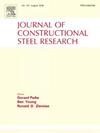结构胶蠕变对 CFRP 加固钢梁性能的影响
IF 4
2区 工程技术
Q1 CONSTRUCTION & BUILDING TECHNOLOGY
引用次数: 0
摘要
本文研究了结构加固环氧树脂粘合剂的粘弹性蠕变响应,并开发了用于数值分析的粘弹性结构模型,以评估其对碳纤维增强聚合物(CFRP)加固钢梁长期性能的影响。数值研究探讨了碳纤维增强聚合物加固钢梁在一年时间内承受三点和四点弯曲的行为,温度范围为 -20 至 60 °C。研究结果表明,在四点弯曲情况下,加劲件可以减少钢材的挠度和峰值应力,但在三点弯曲情况下,加劲件的效果却与之相反。此外,虽然较大的 CFRP 板可以减少板端滑移,但对加固效果的提升有限。粘合剂中粘弹性蠕变的影响更为明显,尤其是在较高温度下。随着时间的推移,滑移的增加会导致钢梁的最大应力和挠度增加,从而降低加固效果。低温环境可以减轻这些负面影响,而高温则会明显加剧这些影响。值得注意的是,在 30 °C 的适度温度下,CFRP 的最大应力可减少 32.25%,这相当于钢应力增加了 4.15%。因此,在使用温度较高的实际应用中,应仔细考虑 CFRP 加固钢梁的蠕变问题,以确保其长期安全性。本文章由计算机程序翻译,如有差异,请以英文原文为准。
Impact of structural adhesive creep on the performance of CFRP-strengthened steel beams
This paper examines the viscoelastic creep response of the structural strengthening epoxy adhesive and develops a viscoelastic constitutive model for numerical analyses to assess its impact on the long-term performance of carbon fibre reinforced polymer (CFRP)-strengthened steel beams. The numerical studies explore the behaviour of CFRP-strengthened steel beams subjected to both three-point and four-point bending over a one-year period, with temperatures ranging from −20 to 60 °C. The results revealed that the stiffeners could reduce the deflection and peak stress in the steel under four-point bending, yet they had the opposite effect under three-point bending. Furthermore, whilst the larger CFRP plates could reduce the slip at the plate ends, they provided only a limited enhancement in the strengthening effectiveness. The impact of viscoelastic creep in the adhesive is more marked and apparent, particularly at higher temperatures. Over time, the increased slip leads to a rise in maximum stress and deflection of the steel beams, thereby diminishing the effectiveness of the strengthening. A low-temperature environment can mitigate these negative impacts, whereas elevated temperatures can significantly exacerbate them. Notably, at a moderate temperature of 30 °C, the maximum CFRP stress can already be reduced by 32.25 %, which corresponds to an increase in steel stress by 4.15 %. Therefore, in practical applications at warm service temperatures, the creep of CFRP-strengthened steel beams should be carefully considered to ensure their long-term safety.
求助全文
通过发布文献求助,成功后即可免费获取论文全文。
去求助
来源期刊

Journal of Constructional Steel Research
工程技术-工程:土木
CiteScore
7.90
自引率
19.50%
发文量
550
审稿时长
46 days
期刊介绍:
The Journal of Constructional Steel Research provides an international forum for the presentation and discussion of the latest developments in structural steel research and their applications. It is aimed not only at researchers but also at those likely to be most affected by research results, i.e. designers and fabricators. Original papers of a high standard dealing with all aspects of steel research including theoretical and experimental research on elements, assemblages, connection and material properties are considered for publication.
 求助内容:
求助内容: 应助结果提醒方式:
应助结果提醒方式:


